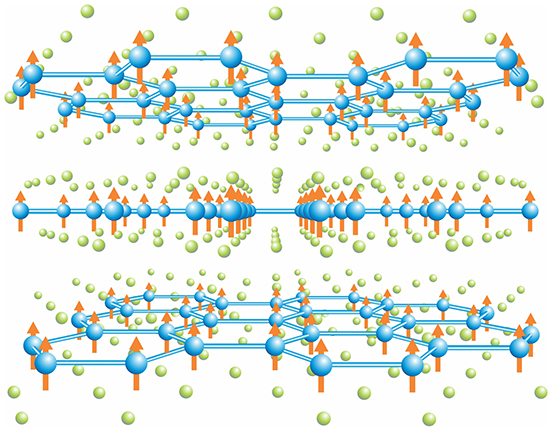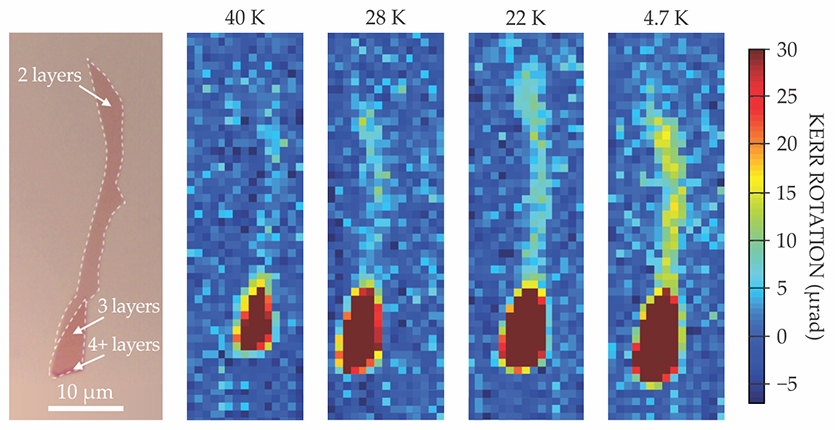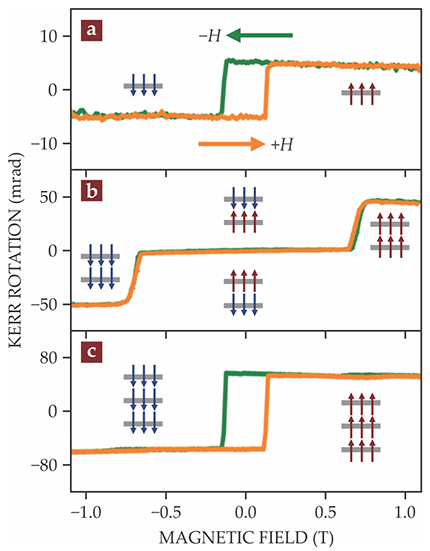Ferromagnetism found in two-dimensional materials
DOI: 10.1063/PT.3.3613
From graphene to black phosphorus and molybdenum disulfide, the past decade has seen fast progress in the field of two-dimensional materials. Made up of atomically thin layers with nothing but weak out-of-plane van der Waals forces to hold them together into a bulk solid, the materials are alluring from both basic and applied points of view. The physics of isolated 2D layers has proven rich and often surprising, in part because the reduced dimensionality changes the way quantum fluctuations compete with long-range order. Device engineers have already fashioned 2D transistors and dream of building all-2D circuitry. (See the article by Pulickel Ajayan, Philip Kim, and Kaustav Banerjee, Physics Today, September 2016, page 38
Of all the types of condensed-matter behavior that have been observed and studied in 2D materials, ferromagnetism has been notably absent. But now two teams—one led by Xiang Zhang of the University of California, Berkeley, and the other by the University of Washington’s Xiaodong Xu and MIT’s Pablo Jarillo-Herrero—have observed clear signatures of ferromagnetism in the 2D materials CrGeTe3 and CrI3. And they’ve both uncovered unexpected new effects that show just how puzzling 2D magnetism may turn out to be. 1 , 2
Flatland magnets
Theorists have long known that there’s something different about magnetism in reduced dimensionality. The 2D Ising model—a planar lattice of interacting spins, each of which can point only up or down—undergoes a phase transition at nonzero temperature to a state with long-range magnetic order. But the 2D Heisenberg model, in which the spins can point in any direction, does not.
In their 1966 solution to the 2D Heisenberg model, David Mermin and Herbert Wagner clarified the situation. They showed that continuous symmetries, such as magnetism in the Heisenberg model, cannot be broken in 2D systems at temperatures above absolute zero because thermal fluctuations destroy any ordered state that tries to form. 3 To exhibit ferromagnetism, they found, a 2D system must be magnetically anisotropic: Though not strictly limited to two states, as in the Ising model, the spins of a 2D ferromagnet must have a so-called easy axis along which they energetically prefer to lie. Real-world magnetic anisotropy, which usually arises from spin–orbit coupling, is not rare. But it’s normally too small to make much difference.
Conventional bulk magnets, such as iron and nickel, show hints of having trouble retaining their magnetism in 2D: Crafting them into thinner and thinner films causes their magnetic transition temperature Tc to plummet. From an applications point of view, that’s not necessarily so bad. Each metal’s bulk Tc is hundreds of degrees above room temperature, so it has plenty of room to fall. But ultrathin films of bulk magnetic materials aren’t suitable for what 2D device engineers have in mind. The films interact so strongly with their substrates that their magnetic properties are affected. And they’re difficult and expensive to fashion into uniform layers of greater than nanoscale length and width.
To behave independently of its substrate and to form large-area, atomically sharp interfaces, a 2D ferromagnet must be a van der Waals material, like the one shown in figure

Figure 1. A ferromagnetic van der Waals material, such as CrI3 shown here, is made up of a stack of 2D crystalline layers held together by strong in-plane covalent bonds but weak out-of-plane van der Waals forces. The magnetic chromium atoms, shown in blue, energetically favor an out-of-plane spin axis. Iodine atoms are shown in green. (Courtesy of Michael A. McGuire, Oak Ridge National Laboratory.)

Field effect
In the five years that Zhang has been working on 2D magnetism, he’s considered several materials. He ultimately ruled out CrI3 because it’s unstable in air and CrSiTe3 because its Tc of 33 K is too low. “We have an intuition that the transition temperature in 2D materials would be lower than it is in the bulk form,” he says, “so we’d better consider those bulk crystals with higher transition temperatures.” He concluded that the most suitable candidate was CrGeTe3—a structural cousin of CrSiTe3—with a Tc of around 70 K.
Few-layer flakes of CrGeTe3 can easily be peeled away from a bulk crystal by mechanical exfoliation, the same “sticky tape” method that spurred the study of graphene (see Physics Today, December 2010, page 14

Figure 2. As the temperature drops on a bilayer and trilayer sample of CrGeTe3, magnetic order appears and strengthens, as evidenced by magneto-optic Kerr effect measurements. The data, however, were collected with an applied magnetic field of 0.075 T; at zero field, the magnetic transition temperature is much lower. (Adapted from ref.

The researchers monitored the material’s magnetic properties using the magneto-optic Kerr effect, or MOKE, the minute rotation in the polarization of a laser beam when it’s reflected off a ferromagnetically ordered material. There are other ways to measure magnetism, such as with a superconducting quantum interference device, but they’re less well suited for 2D samples, which by their nature involve a small amount of material. The MOKE signals from CrGeTe3 are tiny—just tens of microradians—so the Berkeley researchers had to make their measurements with an ultrasensitive instrument in the lab of collaborator Jing Xia at the University of California, Irvine. (An earlier version of the Sagnac interferometer that enabled the sensitive measurements is described in Physics Today, December 2006, page 23
As figure
The data shown in the figure were collected under a small perpendicular applied magnetic field of 0.075 T. That’s a typical practice in studies of magnetic materials: The field helps to stabilize the magnetic moments and dissuade them from forming multiple magnetic domains pointing in all different directions. In bulk materials, the field doesn’t make much difference to the properties of interest. But as Zhang and colleagues discovered, in 2D that’s not the case.
For example, the Tc of a bilayer is 44 K in a 0.3 T field and 28 K in a 0.065 T field. “We estimate that for the bilayer, the intrinsic Tc, under zero field, is probably below liquid-helium temperature, or about 4 K,” says Zhang, “but we did not observe it.” For a six-layer sample, the researchers measured a zero-field Tc of about 10 K, far below the 48 K transition temperature of 0.065 T.
The striking dependence of the transition temperature on the external field was unexpected and unprecedented. Zhang and colleagues interpret their observations as revealing a fundamental difference between 2D and 3D magnets. In bulk materials, the transition to a ferromagnetic state is governed by the exchange interaction between spins and their neighbors. “That’s usually equal to hundreds of tesla,” says Zhang, so it easily overwhelms an applied field of 0.3 T or less.
But in 2D, as Mermin and Wagner showed, the exchange interaction alone doesn’t produce magnetic order; the governing factor is magnetic anisotropy. And the magnetic anisotropy in CrGeTe3 is modest: An off-axis applied field of less than 1 T is enough to orient spins away from their easy axis. A field of a similar order of magnitude, therefore, can have a dramatic effect on the magnetic transition.
Layer effect
Xu and Jarillo-Herrero have each been working on 2D magnetism since 2014, encouraged by work from Oak Ridge National Laboratory’s Michael McGuire that identified the layered ferromagnet CrI3 as a promising candidate material. 4 At a conference in the summer of 2016, they realized their common interest and complementary expertise: Xu’s is making magnetic measurements and Jarillo-Herrero’s is sample preparation and characterization. “So we joined forces,” says Jarillo-Herrero, “and after that, progress was quite fast.”
Bulk CrI3 has a similar Tc to CrGeTe3, 61 K, and stronger magnetic anisotropy—a field of 3 T is required to reorient the spins. It’s also well suited to mechanical exfoliation. But it has the considerable disadvantage of being unstable: If not protected from oxygen and moisture, 2D flakes degrade in a matter of seconds.
The flakes can be exfoliated and manipulated in an inert atmosphere with the help of a glove box, cumbersome as that may be. But Xu’s apparatus for making MOKE measurements doesn’t fit inside the glove box—and furthermore, Xu’s lab is 3000 miles away from Jarillo-Herrero’s lab where the samples are prepared. “It took a long time, but we developed a packaging technique,” says Jarillo-Herrero. “The CrI3 flakes were sealed in a chip carrier with a transparent cover. Even monolayer samples would survive this way for many weeks.”
Optical measurements, including MOKE, could be performed through the transparent lid while the sample sat safe in its oxygen- and water-free atmosphere. Because the MOKE signal from CrI3 is orders of magnitude larger than the signal from CrGeTe3—milliradians instead of microradians—ultrasensitive measurements were not needed.
The researchers sought a telltale signature of ferromagnetism: a hysteresis loop. As an applied magnetic field parallel to the magnetization is swept downward, a ferromagnetic state should remain intact as the field reaches zero and even after it goes slightly negative. Likewise, when the field is swept from negative to positive, an opposite-pointing magnetic state should persist.
Indeed, as shown in figure

Figure 3. Hysteresis loops, which form when a magnetic field H is swept from positive to negative and back again, are a signature of ferromagnetism. In samples of CrI3, (a) the monolayer exhibits hysteresis, (b) the bilayer does not, and (c) the trilayer does. Though not yet fully understood, the results indicate that bilayers tend toward antiferromagnetic order, with one layer spin up and the other spin down. The data shown here were collected at a constant temperature of 15 K. (Adapted from ref.

Xu and Jarillo-Herrero concluded that the bilayer orders antiferromagnetically, with the top layer spin up and the bottom one spin down or vice versa. But why it does that—and why the ferromagnetic order returns in the trilayer—remains unexplained. “Lots of theorists are working now to understand this,” says Xu, “and the possible consequences for novel devices.”
In a 2D device, a ferromagnetic material could be used in components such as sensors and memory modules. Unfortunately, the newly discovered ferromagnets’ low transition temperatures—and CrI3’s instability—make them unsuitable for most practical applications. But the very observation that 2D ferromagnetism is possible suggests that it could also be seen in other, as-yet-undiscovered van der Waals materials. Perhaps one of them will have the right combination of high Tc, chemical stability, and mechanical flexibility.
The search for better 2D ferromagnets will likely proceed in parallel with the exploration of 2D magnetism itself. In addition to clarifying the details of the effects they’ve already observed, Zhang, Xu, and Jarillo-Herrero also hope to work on include how 2D magnets behave when layered with other 2D materials, such as semiconductors, 5 superconductors, and other magnets; whether magnetic properties can be controlled electrically, optically, and mechanically; and the 2D versions of novel spin textures, such as skyrmions.
References
1. C. Gong et al., Nature 546, 265 (2017). https://doi.org/10.1038/nature22060
2. B. Huang et al., Nature 546, 270 (2017). https://doi.org/10.1038/nature22391
3. N. D. Mermin, H. Wagner, Phys. Rev. Lett. 17, 1133 (1966). https://doi.org/10.1103/PhysRevLett.17.1133
4. M. A. McGuire et al., Chem. Mater. 27, 612 (2015). https://doi.org/10.1021/cm504242t
5. D. Zhong et al., Sci. Adv. 3, e1603113 (2017). https://doi.org/10.1126/sciadv.1603113
